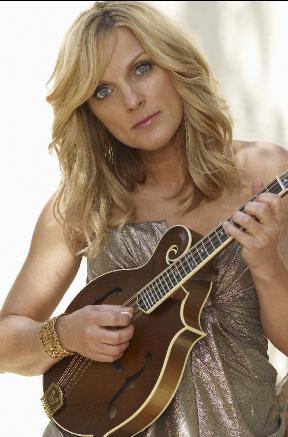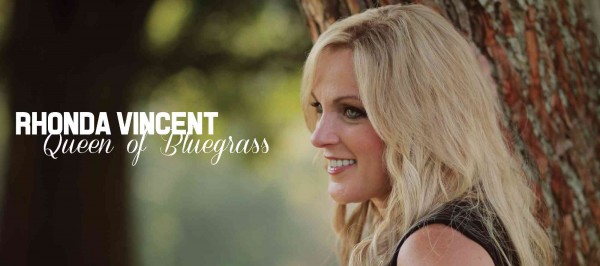
14 Jun Telluride Bluegrass: Rhonda Vincent Returns
Lucky 13.
At least for Festivarians.
After an absence of 13 years, vocalist and fiddler Rhonda Vincent, “The New Queen of Bluegrass,” (Wall Street Journal) returns to town. Rhonda Vincent & The Rage perform Sunday, June 21, 12:30 – 1:45 p.m.on the Main Stage of the Telluride Bluegrass Festival.
Next to Alison Krauss, Vincent is the most decorated woman in bluegrass. And Rhonda Vincent & The Rage are the most decorated band in bluegrass, with over 100 awards to their credit. Among their honors: Song of the Year, Entertainer of the Year, and an unrivaled seven consecutive Female Vocalist of the Year awards from the International Bluegrass Music Association (IBMA).
“When Rhonda Vincent opens her mouth, it’s great… whether she’s singing country or bluegrass. This collection of songs on ‘Only Me’ is incredible. God gave Rhonda an unbelievable voice and I am so thankful that we get to enjoy it. I love her like a sister and enjoy her music as her biggest fan,” Dolly Parton.
Rhonda Vincent was told her voice was too “bluegrass” for mainstream country music. When she sang bluegrass, fans raved that they loved her “country music.” There is only one voice and there is only one Rhonda Vincent. But IS she a bluegrass singer or a country singer? Confused about the difference in the genres? Here’s a short lesson in semantics.
The description commonly offered of bluegrass to distinguish it from mainstream country is its “high lonesome sound.” This phrase was coined in 1963 by New Lost City Ramblers’s co-founder John Cohen, who used it to name a short film he made about Kentucky mountain music. The “high lonesome sound” quickly became a familiar catch-phrase for bluegrass music’s emotionally intense, soaring-to-the-point-of-audible-strain vocal style, a style that often gives even happy songs a bleak undercurrent.
And unlike mainstream country music, bluegrass is traditionally played on acoustic stringed instruments. The fiddle, five-string banjo, guitar, mandolin, and upright bass (string bass) are often joined by the resonator guitar (also referred to as a Dobro) and (occasionally) harmonica or jaw harp.
However, bluegrass and country music are part of the same family, branches from a shared musical root system that also spawned blues, jazz, and rock and roll.
Vincent puts the cap on the “bluegrass or country” question once and for all with her latest release, Only Me (Upper Management), an ambitious double-album that is a little bit country, a little bit bluegrass – and a whole lot awesome. Across 12 songs – six bluegrass songs on one CD, six country songs on the other – Vincent shows that she is a true artist not confined by strict musical genres or corralled by boundaries set in place by music industry honchos. Vincent is a singer’s singer, true and pure.
“My voice is the common denominator in all of this,” Vincent said. “It’s always exciting to hear each individual’s perception when they hear it for the first time.”
Only Me was nominated for Best Bluegrass Album at the 2015 Grammys. The album features duets with both Willie Nelson and Daryle Singletary.
“Her vocalizations are emotional, carry the song and place it firmly on solid ground. These are the characteristics of a true professional entertainer,” Cybergrass
“Only Me” was inspired by Vincent’s performance on the Grand Ole Opry the day after George Jones died on April 26, 2013. She sang one of George’s songs, “When the Grass Grows Over Me,” a song that she recorded for the country CD of “Only Me.”
In fact, it was while opening for Jones in 2000 that Vincent understood how blurry the line separating bluegrass and country music can be. Vincent grew up in Northern Missouri in the toy town of Greentop, the fifth generation of the musical Vincent family. She began her musical career at age five, performing on the family local TV and radio shows as “The Sally Mountain Show.”
The Sally Mountain Show was a musical outfit that also featured her father, Johnny, mother, Carolyn, little brothers, Darrin and Brian, everyone singing a mix of music that included tunes by the Louvin Brothers, Loretta Lynn, Bill Monroe and Kitty Wells. For a young Rhonda Vincent, all of those songs got rolled up into a single ball.
Vincent picked up drums at age six, the mandolin at eight, and the fiddle at ten, continuing to perform with the family band at festivals on weekends. In her mid-twenties, after appearing on TNN’s nationally televised “You Can Be a Star,” Vincent struck out on her own, singing with the Grand Ole Opry’s Jim Ed Brown, which eventually led to a record deal.
First, she sang bluegrass. Then she recorded a couple of mainstream country albums in the 1990s, when makeup artists cared more about her looks than her sound. She was asked if she could “get the bluegrass out of her voice.” Confused and heartbroken, she decided to go full-bore into bluegrass music and formed her incredible band The Rage. One night in Salem, Va., while opening for The Possum, Rhonda Vincent & The Rage blew the roof off the building. Afterward, as she signed autographs and sold out of bluegrass CDs, Vincent listened with awe as new fans gushed, “We love your country music!”
Whatever lights your fire.
To learn more about Rhonda Vincent, click the “play” button and listen to our conversation.







Sorry, the comment form is closed at this time.